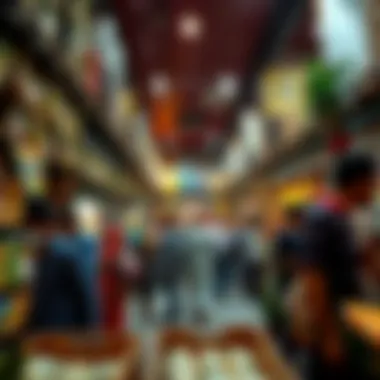Exploring the Significance of Khan Stores in Retail


Market Trends and Analysis
The landscape of retail has undergone a seismic shift over the past few decades, with Khan stores evolving into pivotal components of local economies. Understanding the current market trends surrounding these establishments is crucial for anyone looking to gain insights into retail dynamics.
Current Market Conditions
At present, Khan stores are not just shops; they are lifelines for many communities. They often serve as the nucleus of neighborhood commerce, blending traditional practices with modern demands. Consumer behavior has transformed significantly, with shoppers increasingly leaning towards personalized experiences that Khan stores can offer, unlike larger chain retailers. This change is reflected in the burgeoning popularity of local products, artisanal goods, and culturally relevant items that resonate with community identity.
In addition, the rise of technology has reshaped shopping patterns. Many Khan store owners are adapting by integrating digital solutions, such as online ordering and social media marketing. These strategies not only enhance customer engagement but also expand their reach beyond geographical boundaries. Here’s a closer look at some current market elements affecting Khan stores:
- Increasing consumer preference for local products
- The integration of e-commerce and traditional retail
- Growing importance of social media for customer engagement
Future Projections and Opportunities
Looking ahead, the future of Khan stores appears not just promising but ripe with potential. Retail analysts predict a shift towards hyper-localization, where businesses cater specifically to the needs and tastes of their neighboring customers. In light of this, Khan stores can seize the opportunity to enhance their community ties and diversify product offerings.
Moreover, the sustainability movement is gaining traction. Consumers are becoming more conscious of their choices, favoring establishments that promote eco-friendly practices and local sourcing. Investing in sustainable practices could provide Khan stores with a competitive edge in a market increasingly driven by ethical consumption.
Community-centric retail spaces like Khan stores will likely become essential in shaping the social fabric and economic framework of local areas for years to come.
Investment Strategies
Investing in Khan stores can be not only lucrative but also socially impactful. Understanding where to invest and how can make all the difference.
Best Areas for Investment
Research indicates certain locales show a higher potential for Khan store investments:
- Urban Centers: High foot traffic and a mix of demographics can boost sales.
- Cultural Hotspots: Areas that celebrate diversity often appreciate and support local businesses more.
- Suburban Developments: As more people move to the suburbs, local stores become essential for meeting their needs.
Tips for Property Investors
When considering investment in Khan stores, keep these suggestions in mind:
- Conduct Thorough Research: Know the demographics of the area and the specific needs of the community.
- Embrace Flexible Concepts: Consider backing stores that are open to changing their business model based on current trends.
- Support Local Initiatives: Engaging with community programs can foster loyalty and potentially boost sales.
In summary, the intricate world of Khan stores presents numerous opportunities for investors willing to dive deep into the local culture and market trends. Educating oneself about these nuances can lead to informed decisions that drive both economic growth and community development.
Historical Context of Khan Stores
The historical backdrop of Khan stores provides a crucial lens through which we can appreciate their evolution and the roles they play in society. This context is particularly significant when evaluating of how retail traditions have been shaped over time, highlighting unique practices that bind communities together. In the realm of commerce, understanding the origins and development of Khan stores can illuminate existing patterns in consumer behavior and economic structures.
Origins and Development
Khan stores trace their roots back to ancient marketplaces where traders would gather to sell goods, barter, and exchange cultural ideas. Unlike modern retail chains, these establishments often embody a rich tapestry of tradition. For example, the concept of the Khan—meaning an inn or caravanserai—originally served as shelters for travelers, facilitating trade across regions. As civilizations grew, so did the function of Khans, transforming them into commercial hubs. In places like Central Asia, Khan stores became critical to local economies, cementing their status as central fixtures in their communities.
From the bustling bazaars of ancient Persia to contemporary urban centers, the evolution of these stores is nothing short of fascinating. They have adapted to changing societal norms and consumer expectations while still retaining their core values. With the emergence of colonial trade routes in the 18th and 19th centuries, Khan stores began to amalgamate international goods with local craftsmanship—blurring lines between local artisanship and exported commodities.
As communities developed, Khan stores became synonymous with trust, reliability, and family-run enterprises that defined local enterprise. Speak to any elder in a traditional market, and they would likely regale you with stories of how dealings were often accompanied by warmth and familiarity—a stark contrast to the impersonal nature of today’s digital shopping experiences. This allegiance to local traditions is what continues to make Khan stores not just places to shop, but pillars of community life.


Architectural Features
Architecturally, Khan stores hold a treasure trove of stories embedded within their structures. Traditionally, these stores were designed with practicality in mind, often featuring open layouts that fostered easy navigation for patrons. Many of them also exhibited a unique blend of local architectural styles, such as domes, arches, and intricate tile work that reflect cultural narratives.
For instance, you might find a Khan store embellished with intricate mosaics and adorned with murals depicting historical events or the regions' heritage. The open-air courtyards typical of these establishments allow for social interaction, serving as vibrant communal spaces where people meet, chat, and exchange news, thus transforming commerce into a social gathering.
"In many cultures, the architecture of Khan stores reflects not just utility but also a communal spirit that links the past with the present."
In the modern era, some Khan stores have integrated contemporary retail principles and sustainability practices into their design, such as using environmentally friendly materials and optimizing space for better customer engagement. These adaptations, however, have not erased their historical essence; rather, they weave the old with the new, creating an intriguing juxtaposition for visitors and locals alike.
Overall, the historical context of Khan stores is a narrative of continuity and change. Understanding this context allows investors, agents, buyers, and analysts to appreciate the deep-rooted cultural significance of these establishments, which continue to shape economic behaviors and community dynamics today.
Relevant resources include Wikipedia on Traditional Markets and Britannica on Bazaars for those keen on delving deeper into the topic.
Cultural Significance
Khan stores hold a unique place within the cultural fabric of communities. They are not just places to buy goods; they serve as a backdrop for social interactions and exchanges that reflect the community’s identity and values. The significance of these stores extends well beyond their commercial role, interfacing with social traditions and local customs.
Role in Community Life
In many neighborhoods, Khan stores are the lifeblood that sustains community ties. People congregate there, creating a hub of activity that goes beyond mere shopping. This setting allows for conversations to flow, plans to be made, and relationships to flourish. These stores often become informal meeting points where neighbors greet each other and catch up on local news. The familiar faces of store owners and employees help foster a sense of connection and belonging.
- Accessibility to Goods: Particularly in areas where larger retail chains might not have a presence, Khan stores provide essential access to a variety of products. This ensures that members of the community can obtain what they need without extensive travel.
- Cultural Exchange: Many Khan stores curate products that reflect the local culture and diverse backgrounds of their patrons. This variety encourages cultural exchange among community members, enriching the local tapestry.
- Support for Local Economy: When residents choose to shop at these stores, they contribute directly to the local economy, assisting in the circulation of money within the community. This, in turn, supports local jobs and stimulates economic activities.
“Khan stores are more than just retail spaces; they weave the social fabric of neighborhoods, creating a sense of belonging for everyone.”
Khan Stores and Local Traditions
Khan stores also play a pivotal role in preserving and promoting local traditions. They often stock items that hold cultural significance, including:
- Traditional Food Products: Many stores feature local delicacies or homemade goods that resonate with the community's heritage, which is particularly important during festive seasons.
- Handcrafted Goods: Selling local crafts helps keep cultural practices alive, diversifying the array of available goods while also serving as a platform for local artisans.
- Celebration of Festivals: During local festivities, Khan stores often act as the go-to places for buying decorations, special foods, and gifts, underscoring their role in cultural celebrations.
In essence, Khan stores don’t just cater to the needs of the community; they become integral to maintaining its cultural integrity and rich traditions. By facilitating interactions and providing culturally relevant products, they nurture a sense of pride and identity among community members.
Economic Impact
The economic significance of Khan stores cannot be overstated. These marketplaces serve as vital cogs in the wheel of local economies, providing both a platform for traditional commerce and a bridge to modern retail practices. They foster an environment where local entrepreneurs can thrive and established businesses can adapt to shifting consumer demands. In essence, Khan stores are not just shopping destinations; they are community hubs that energize the economy and sustain livelihoods.
Contribution to Local Economies
Khan stores contribute substantially to local economies in several ways. First and foremost, these stores amplify the local supply chain. By sourcing products from regional producers, they help keep money circulating within the community. For instance, a Khan store in a small town may stock produce from local farmers, ensuring that the income made at the checkout stays put and spurs further spending on local services and goods.
Moreover, these establishments often engage in community support—sponsoring local events, festivals, or sports teams. This commitment not only strengthens community ties but also enhances brand loyalty among consumers. When shoppers see their money making an impact, they are more likely to frequent these stores over larger, faceless retailers.
Additionally, Khan stores often adapt their offerings to meet local tastes, incorporating regional flavors and products. This approach not only satisfies customer preferences but also promotes the cultural heritage of the area, further anchoring the economic benefit.
- Local Sourcing: Keeps dollars local, enriching the community.
- Community Engagement: Promotes goodwill and encourages customer loyalty.
- Cultural Representation: Tailors products to suit local tastes, promoting heritage.
Employment Opportunities
Khan stores are significant employers within their communities, creating a wide range of jobs that cater to different skill sets. From cashiers to managers, these positions are often filled by local residents, helping to reduce unemployment rates and fostering community resurgence. The sheer variety of roles available allows individuals to gain valuable work experience, which can serve as a stepping stone for further career opportunities.


In addition to direct employment, these stores can stimulate indirect job creation. For example, a Khan store needs maintenance staff, delivery drivers, and security personnel, thus encouraging the growth of ancillary services. This ripple effect can lead to job creation in sectors such as cleaning, transportation, and even technology, depending on how modernized the Khan store is.
"Khan stores exemplify local resilience, not just through their economic contributions but by being crucial employment sources; they reflect the heart of the community's workforce."
Khan stores can also offer valuable training programs for their employees, building skills that are applicable in other industries. This investment in employee development ultimately enhances the employability of the local workforce, paving the way for a more robust economy in the long term.
- Direct Jobs: Positions filled by locals help combat employment challenges.
- Indirect Jobs: Stimulates demand for ancillary services.
- Skill Development: Programs that equip locals for varied job paths.
Diverse Product Offerings
Khan stores stand as pillars of retail diversity, reflecting not only the needs of their immediate communities but also the broader cultural tapestry they inhabit. This diversity is not merely about the various items on the shelves but encompasses the rich stories behind traditional goods and the innovative practices that shape the modern shopping experience. By embracing a wide range of products, these marketplaces cater to a spectrum of consumer needs, thus playing a crucial role in local economies and social life.
Traditional Goods
Traditional goods found within Khan stores serve as a vital cultural bridge, allowing shoppers not just to purchase items, but to engage with their heritage. These products can range from handwoven textiles to time-honored spices that evoke flavors passed down through generations. The significance of these items goes beyond mere functionality; they possess intrinsic value tied to identity and history.
- Cultural Preservation: Many traditional goods, such as handmade pottery or organic produce, are often crafted using age-old techniques that echo the traditions of artisans long gone. This promotes awareness around local heritage and supports efforts in preserving these crafts.
- Economic Opportunities: These products also empower local artisans by providing them a marketplace and fair compensation, thus allowing them to thrive in their communities.
- Consumer Connection: For buyers, purchasing traditional goods encourages a sense of belonging, as these items often carry with them stories and meanings tied to cultural identities. It allows individuals, especially expatriates, to retain a connection to their homeland.
Modern Retail Practices
As the landscape of retail evolves, Khan stores have adeptly integrated modern practices while retaining the charm of their traditional roots. The blending of old and new has become a hallmark of their operations.
- Technology Integration: Modern inventory management systems enable these stores to keep track of products efficiently. By using point-of-sale systems and online platforms, they are improving customer experiences, making it easier for buyers to receive tailored recommendations based on past purchases.
- Customer Amenities: Innovations in customer service, such as loyalty programs and personalized shopping experiences, are making their way into Khan stores. Examples include having well-planned layouts and interactive displays that engage customers more actively.
- Sustainable Practices: A growing shift towards sustainability is evident as many Khan stores adopt eco-friendly practices. This can involve sourcing products locally, thus reducing carbon footprints, and offering reusable packaging options which resonate with a more environmentally-conscious consumer base.
The future of Khan stores hinges on maintaining a balance between traditional offerings and modern practices, creating a harmonious shopping atmosphere that appeals to both nostalgia and innovation.
Overall, the diverse product offerings at Khan stores are a testament to their adaptability and significance in modern society. They are a microcosm of cultural identity, economic opportunity, and a glimpse into how traditional and contemporary retail practices can coexist beautifully.
Modern Trends in Retail
The retail landscape is ever-evolving, and Khan stores are no exception. Modern trends in retail are crucial because they reflect the changing preferences of consumers and the subsequent adaptations that businesses must undertake to remain relevant. In the context of Khan stores, these trends highlight the integration of technology and innovations in customer experience, both of which are essential for survival amidst stiff competition.
Integration of Technology
Today’s consumers expect a seamless shopping experience, and technology has become the backbone of this transformational shift. In Khan stores, this integration manifests through various means. For instance, many stores are adopting digital payment systems which streamline transactions, making it easier for customers to complete purchases with ease. Rather than fumbling for cash or counting change, shoppers can simply tap their cards or use their smartphones.
Additionally, some Khan stores are starting to employ inventory management systems that utilize data analytics to predict stock levels and manage supplies more efficiently. This not only avoids stockouts but also reduces waste, saving money in the long run. As technology continues to advance, it is not surprising that customers are beginning to appreciate personalized shopping experiences powered by data tracking and AI, which can offer product suggestions based on previous purchases.
Customer Experience Innovations
In an age where experience trumps mere transactions, Khan stores are innovating to enhance customer experience. One notable trend is the enhancement of in-store engagement strategies, like interactive displays and digital kiosks that provide product information or even tailored recommendations. This approach encourages customers to spend more time in-store, engaging with products in a way that online shopping cannot replicate.
Furthermore, understanding that word-of-mouth remains a powerful tool, some Khan stores are leveraging social media to create vibrant communities around their brands. They’re hosting events, such as cooking classes or cultural festivals, which not only promote products but also reinforce their cultural significance. Customers relish these experiences, contributing to a stronger community bond and loyalty to the store.
In summary, modern trends in retail not only affect how Khan stores operate internally but also reshape their relationships with customers and the surrounding community. While these transformations can present challenges, such as the need for continuous adaptation, they also open doors to innovative opportunities. This dynamic interplay, therefore, is not just about keeping pace with the market but about thriving within it.
Challenges and Opportunities
In the evolving landscape of retail, Khan stores face myriad challenges and opportunities that shape their very essence. Understanding these elements is crucial when examining the sustainability and future of these marketplaces. Many factors interplay here, whether they be the burgeoning influence of online shopping or the pressing necessity for sustainability practices. Each aspect offers both hurdles to overcome and advantages to seize in the competitive arena.
Competition from E-Commerce


The rise of e-commerce has undoubtedly revolutionized the shopping experience, impacting brick-and-mortar establishments like Khan stores. With giants like Amazon setting the pace, local retailers grapple with maintaining their foothold in an increasingly digital world. Here are a few points to consider regarding this competition:
- Shifting Consumer Behavior: Many consumers now prefer the convenience and accessibility of purchasing products online, leading to a gradual decline in foot traffic across traditional retail outlets. Khan stores, often viewed as community hubs, must adapt to this changing landscape.
- Adoption of Omni-channel Strategies: To compete effectively, Khan stores are exploring new channels of engagement. Some establishments are implementing e-commerce platforms that allow customers to shop online while picking up in-store, marrying convenience with the personal touch of local shopping.
- Customer Loyalty: Despite the allure of online shopping, loyalty to local businesses remains strong among some demographic groups. Khan stores can leverage this asset by fostering community connections and offering unique, locally-sourced products that are hard to find online.
While the online retail revolution poses challenges, it also encourages innovation. Khan stores must embrace technological advancements and redefine their customer engagement strategies to thrive in this new era.
Sustainability Practices
As the environmental movement gains traction, sustainability has become a significant talking point within retail. Khan stores are not just retail spaces; they represent a blend of culture and community consciousness. Here are some sustainability practices currently implemented or considered by Khan stores:
- Ethical Sourcing: Many Khan stores are shifting towards sourcing products from local farmers and artisans. This not only cuts down on carbon footprints associated with long-distance transportation but also strengthens local economies.
- Waste Reduction: Initiatives aimed at reducing waste are becoming commonplace. Some stores have started introducing measures like compostable packaging and minimizing plastic use, which resonate with environmentally conscious consumers.
- Community-Inclusive Practices: Sustainability isn't just about the environment; it's also about social responsibility. Khan stores are increasingly engaging with their communities, organizing programs that educate consumers about the benefits of sustainable living and responsible consumption.
Embracing sustainability is no longer optional; it's a vital strategy that can enhance brand image and foster consumer loyalty.
Future of Khan Stores
The future of Khan stores stands as a pivotal focal point in understanding how these marketplaces can adapt and thrive in an ever-changing retail landscape. As we peel back the layers of this topic, it becomes clear that these establishments are more than just shopping spots; they reflect evolving consumer habits, preferences, and technological advancements. As customers veer towards convenience, sustainability, and personalization, Khan stores face both challenges and opportunities that could redefine their role in local economies.
Evolving Consumer Preferences
In the age of information, consumers have become increasingly discerning. Their shopping choices are no longer driven solely by price, but also by principles and experiences. Today’s shoppers are looking for more than products; they seek meaningful connections with the brands they support.
- Value for Money: Modern consumers are hyper-aware of their spending. Much like navigating through a maze, they want to get the most bang for their buck. Khan stores that offer quality products at fair prices may remain the go-to for daily needs.
- Sustainability: The green movement is here to stay. Shoppers are now gravitating towards stores that practice ethical sourcing and sustainability. Khan stores that can showcase their commitment to the environment may see an increase in footfalls.
- Cultural Relevance: As cultural identities morph and blend, consumers find it essential to patronize stores that acknowledge local traditions. Khan stores that integrate cultural aspects into their offerings are likely to resonate more profoundly with their clientele.
The shift in preferences necessitates that Khan stores keep their fingers on the pulse of their communities, ensuring they align with what their localities value most.
Potential Innovations
Innovation isn’t just a buzzword; it’s the lifeblood that will keep Khan stores alive and kicking. What’s on the horizon? It’s an exciting mix that could redefine how these markets operate and engage their customers.
- Technology Integration: Advances in technology are ripe for adoption. For example, implementing mobile payment systems, inventory tracking through smart technology, and even the possibility of augmented reality experiences can enhance the shopping experience.
- Omni-channel Strategies: With a blend of online and offline shopping, Khan stores need to create seamless experiences. Offering services like click-and-collect, where consumers can order online and pick up in-store, could be a game-changer.
- Community Engagement: Implementing local events or workshops can create a stronger community bond. Whether it's hosting food tastings or craft nights, fostering customer loyalty through engagement can be remarkably beneficial.
The future of retail isn’t just about what you sell; it’s about how you connect.
Concluding Thoughts
Khan stores hold a significant place not just in the heart of the communities they serve, but also in the broader landscape of retail. Their relevance transcends mere commerce; they are a convergence of culture, history, and economic vitality. The complexities of their operations and the evolution they have undergone highlight a larger narrative about how localized businesses can thrive despite myriad challenges.
Summary of Insights
In examining Khan stores, some key insights emerge:
- Historical Value: These establishments are often steeped in rich traditions, promoting local heritage and storytelling through their products.
- Economic Contributions: They serve as economic pillars in their communities, not only by generating revenue but also by creating jobs and stimulating local business ecosystems.
- Cultural Relevance: Khan stores are often mirrors of cultural diversity, reflecting the lifestyle and values of the neighborhoods they are part of.
- Adapting to Change: Despite facing modern challenges, including competition from e-commerce giants, many Khan stores are adapting by integrating technology and enhancing customer experiences.
This convergence of elements paints a comprehensive picture of Khan stores as more than just retail outlets; they are community hubs that navigate the intricacies of commerce while retaining their unique identity.
Implications for Stakeholders
Understanding the dynamics of Khan stores is crucial for various stakeholders:
- Investors can uncover opportunities for growth by aligning with community-centric business models, recognizing the value of supporting local economies.
- Buyers may find that shopping at Khan stores offers not just products but unique experiences, thereby enriching their consumer journey.
- Analysts studying retail trends should take note of how these stores adapt to modern challenges and the strategies that help sustain their relevance.
- Expatriates can benefit from the authentic local culture that Khan stores embody, offering insights into the socio-economic fabric of the area.
By acknowledging these points, stakeholders can navigate their interactions with Khan stores more effectively, appreciating the multifaceted roles these establishments play in enriching community life and economy.
"In a world driven by rapid changes, keeping sight of local treasures like Khan stores ensures we remain connected to our roots and communities."
Whether through fostering employment, showcasing local artisans, or simply being a gathering place for neighbors, the implications of Khan stores stretch far and wide, influencing not just the economy but also the cultural landscape.











